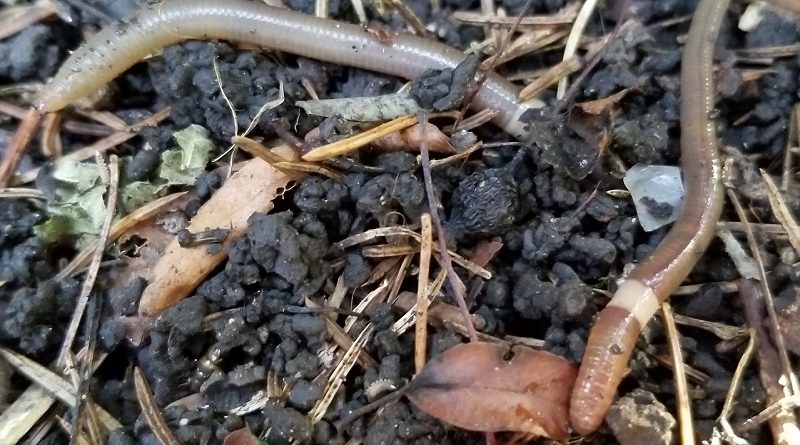Jumping Worms Derangement Syndrome
Podcast: Play in new window | Download (Duration: 1:46:04 — 50.8MB)
Subscribe: Apple Podcasts | Spotify | Android | iHeartRadio | Podchaser | Email | TuneIn | RSS | More
(August 18, 2019) I already knew about an invasive species called jumping worms when I recently posted a Chicago Tribune story on Facebook. But when I read the description of the worms and I thought about my garden, I thought, “Uh-oh.” See the photo above? Those are jumping worms. I took that photo a few days ago in my backyard. Nice.
It isn’t as if we never see invasive species in our own neighborhoods. Think Japanese beetles, house sparrows and dandelions. And worms. Yup, earthworms are invasive species in the Midwest. But there’s something creepy (literally!) about having jumping worms in your backyard. Especially when they make headlines in the local newspaper.
What I didn’t expect was the weird and varied reaction to my Facebook post. One person just couldn’t believe that they could possibly be a problem. After all, they’re worms! And worms are good, right? Another person commented that this must be a boon to people who love to fish. Even when I pointed out that anglers have long dumped worms into water and on land, spreading them around the country, he seemed unfazed. Some folks freaked out and some yawned and said, “Old news.” Hence, the headline to this post.
So let’s take a quick look at this latest exotic animal invasion. The Tribune story links to a publication from the University of Illinois Extension. It’s called, unsurprisingly, Invasive Species Alert: Jumping Worms.
Jumping worms, (Amynthas spp.) have recently been discovered in Illinois. This new invasive species was first identified in Illinois in 2015 in northern Illinois and in 2016 in southern Illinois. Jumping worms are earthworms native to East Asia. They also have been called crazy worms, Alabama jumpers, and snake worms.
Why? Because, when disturbed, they writhe or thrash about violently. Some reports say they sometimes actually jump, hence the name. And they are already here to stay. Various articles note that jumping worms have been found throughout the east coast, in Oregon and now in the Midwest. The Wisconsin DNR wrote about them in four years ago in Wisconsin Natural Resources Magazine.
All earthworms are invasive and they can cause a lot of problems in places they don’t belong, like Wisconsin’s northern forests. Jumping worms are a concern because they can consume the litter layer faster than any other earthworm in the state. Where jumping worms are present, fallen leaves and topsoil are processed by the worms until the soil becomes granular, dry and looks similar to coffee grounds. We have even observed a decline in European earthworms where jumping worm populations are established. Research is ongoing to better understand why this happens.
Hmm. Did you notice the soil in the photo from my yard? Looks like coffee grounds to me. I think I’m screwed.
Anyway, we’re going to get more information this morning. We welcome Christopher W. Evans, Illinois Extension Forestry and Research Specialist in the Department of Natural Resources and Environmental Sciences. He, along with Diane E. W. Plewa from the University of Illinois Plant Clinic, put together the alert noted above.
Meet the Nowaks: This is Tom
It was more than three years ago and Peggy and I were still at Pirate Radio. Arrrrgh! One of my guests was a guy named Tom Nowak (no relation–he doesn’t even pronounce it the same). I had met him at an environmental rally at Daley Plaza, and I hadn’t lost his card, so I invited him on the show.
 Tom is founder and Principal of an outfit called Quantum Financial Planning LLC. Tom is an hourly, fee-only financial planner and is the author of two books on sustainable investing (Low Fee Socially Responsible Investing and Low Fee Vegan Investing). Tom’s first career as a scientist provides him with some additional insights into investing in the age of climate change
Tom is founder and Principal of an outfit called Quantum Financial Planning LLC. Tom is an hourly, fee-only financial planner and is the author of two books on sustainable investing (Low Fee Socially Responsible Investing and Low Fee Vegan Investing). Tom’s first career as a scientist provides him with some additional insights into investing in the age of climate change
I have continued to run into Tom from time to time at places like the McHenry County College Green Living Expo, which we support each year. So I figured it was time to bring him back to see how sustainable investment is doing now that our country has lost its moral compass.
In his own words,
In a world rapidly moving towards sustainability, green, or ESG (Environmental, Social and Governance) investing can help the planet, align your investments with your values, and avoid investment in companies which are likely to do poorly in a world rapidly moving towards sustainability.
He’s obviously more optimistic than I am. Anyway, you don’t want financial advice from me, so Tom has some sources that you might find useful. You can start with this report from US SIF (US Social Investment Forum). Then he has some more suggestions.
- ussif.org – see mutual funds section
- etf.com/channels/socially-responsible
- yahoo.com/finance – see individual stock sustainability ratings
- Morningstar.com – see mutual fund sustainability (globe) ratings
Finally, when I asked him about the best way to make your money count, he said,
Short answer is that it’s about one’s worldview as to what action they can take that has the most impact. We all have different options based on our circumstances and skill set. The book Drawdown outlines 100 big things that can be done to address climate change. If we all pick at least one to focus on (and stay out of the way of others do their best to help).
Meet the Nowaks: This is Julie
We’re getting one stop shopping on today’s show. Julie Nowak is married to Tom (no, she’s not related to me, either), and she’s not a finance person. Julie describes this paragraph she wrote about herself as “cheeky.” I like cheeky, so here we go.
Dancer, chemist, industrial hygienist (whatever that is), Medical Reserve Corps volunteer, volunteer climate advocate. Throughout her academic preparation and professional life, Julie has brought the brought the values of personal responsibility, “Do no harm” and “Leave no trace” to her work in the here-and-now. When she became a mom, she extended those values to her daughters’ future. This has taken on a greater urgency after the recent wedding of her first daughter. Julie, who hates politics, has been a citizen volunteer lobbying Congress with Citizens’ Climate Lobby since retiring from paid employment in 2014.)
Julie is actually the co-founder and leader of the Lake County, IL chapter of Citizens’ Climate Lobby. She’s here today to talk about the Energy Innovation and Carbon Dividend Act, which is described as a “the bipartisan climate solution.” I didn’t think the “bipartisan” thing happened anymore, so that’s one of the questions I will ask her. BTW, it’s a real bill with a real name, H.R.763 – Energy Innovation and Carbon Dividend Act of 2019.
I wrote to Julie with a number of questions and she took the time to answer them, so we’re going to review that Q&A right here.
Mike: I wonder if you can talk about the difference between a carbon “fee” and a carbon “tax.” (I suspect they’re basically the same, with improved marketing for the “fee.”)
Julie: Tax: A tax has the primary purpose of raising revenue to fund the government.
Fee: A fee generally recovers the cost of providing a service. In this case, the “service” is providing the commons as a place for carbon waste. Since CCL advocates for revenue-neutrality and a policy that doesn’t grow the government, we are advocating for a fee, not a tax.
In common discussion, however, “carbon tax” and “carbon fee” are used interchangeably, and generally refer to the same type of legislation. The endpoint is the same: include the damage that carbon pollution (and other greenhouse gases) is (are) doing to the climate, oceans, and health in the price of energy across multiple sectors of the economy.
It is muddy, even for economists.
https://www.taxpolicycenter.org/taxvox/what-tax
https://www.taxpolicycenter.org/taxvox/tax-or-fee-label-could-matter
Mike: Do they work? This New York Times article reports on a success story…kind of.
Julie: We know that the status quo –the current pricing and subsidizing of fossil fuels and other greenhouse gases– is certainly not working, at least not fast enough to get the job done.
It depends on several factors. I have seen reports that they don’t work if they are not high enough. British Columbia started out strong, but it did not rise predictably and more exemptions managed to sneak in, diluting the effect. On the other hand, Finland and Sweden have had a pretty high carbon tax in effect since the early 1990’s, while its economy has done pretty well.
HR 763 has built-in checks that specifically call for additional regulation if the targeted reductions are not met.
https://ourworldindata.org/carbon-pricing-popular
Mike: How does the Green New Deal fit in with this act?
Julie: By elevating climate change in the media and in the halls of Congress, the Green New Deal has made it easier to talk about taking the next steps: developing and passing specific legislation to achieve each of those goals.
Energy Innovation and Carbon Dividend Act of 2019 (H.R. 763): This is specific legislation introduced earlier this year in the House that will reduce US emissions by at least 40% in the first 12 years, and 90% by 2050, while protecting the poor and middle class. This is a powerful first step for transitioning away from fossil fuels while creating jobs and boosting the economy. The dividend helps people through the transition to clean energy, and rewards those with lower carbon footprints.
In addition to being a specific bill that can get going on the critical work of rapidly reducing greenhouse gas emissions, HR 763 has both a Republican and a Democratic co-sponsor (Francis Rooney, FL-19, and Ted Deutch, FL-22, respectively). A broad coalition of support from community leaders, businesses, local legislators, and more than 130,000 CCL supporters across the country, has helped this bipartisan bill gain traction in the House and have good prospects in the Senate.
Members of Congress see no conflict: half of the 59 cosponsors of the Energy Innovation Act in the House have also signed on cosponsoring the Green New Deal, as well.
I asked her more questions and she gave me more answers, but that’s why I have a radio show and why you should listen.


